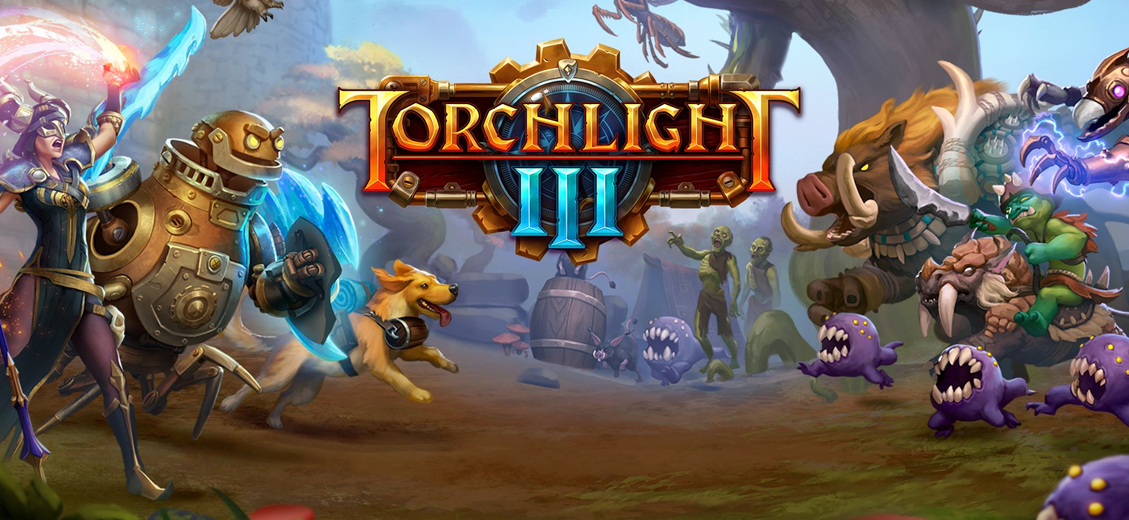Complete Torchlight 3 Review Introduction
Launching a new franchise of ARPG, the very first Torchlight was released in October of 2009. It was highly rated, sold well, and directly competed with other ARPGs. Because of its success, Torchlight II released in September of 2012. This next iteration of the franchise also received great ratings and sold very well. Both games were developed by Runic Games (founded by Travis Baldree, Max Schaefer and Erich Schaefer, Peter Hu, and the Flagship Studios Seattle team responsible for Mythos). The Torchlight series brought a unique cartoon “feel” to the ARPG space while also simplifying numerous mechanics with a focus on replayability and modding. Over time, both TL1 and TL2 were expanded greatly by the mod community, ensuring the longevity and continued success of the titles.
I’ve taken 3 characters (Sharpshooter, Railmaster and Forged) to 60+ in Ridiculous difficulty, and have experienced all game content.
Torchlight III (TL3) was developed by Echhra Games (founded by Max Schaefer, one of the creators of Diablo and Torchlight 1 & 2) and officially released on October 13, 2020. It was previously known as Torchlight Frontiers, but they changed the name to TL3 just a few months ago.
- Developed by: Echtra Games
- Original Release Date: October 13, 2020 (PC, PS4, XBox), October 22 (Switch)
- Release Reviewed: 99388 (October 2020)
How does TL3 compare to its predecessors? Let’s find out!
Content
“We want to keep making this for awhile. Unlike Torchlight 1 and 2, this will be a living, breathing universe that grows over time.” — Max Schaefer, creator of Torchlight 3 (Interview from 10.15.2020)
TL3 continues the legacy visual style of cartoon-like worlds packed full of goblins, spiders, demons and other nasty creatures, all narrated in an entertaining fashion with casual and even comical dialogue. This unique slapstick representation continues with the latest installment of the game.
The goal of previous Torchlight games was to simplify the quick injection of a character into a fun and active world. TL3 is no different. When creating a character, the first option is to select one of four Classes to play. The Sharpshooter is the ranged attacker. The Dusk Mage is the magic-using specialist. The Forged is a silly robot that specializes in both guns and melee, and the Railmaster is a pet-oriented class, but also one of the most unique classes in an ARPG. Once the class is selected, the customization options are simplified; players can choose: Gender, Skin Color, Head, Hair, and Hair Color.
The next step is to choose the Relic for your character. This is the augmentation for your base class, allowing for a different style of play depending on what your interests are. This choice determines the path of the character and cannot be changed. Bane is the poison and pet-based relic, enabling your character to summon spiders, exploding poisonous balls, and more. Blood Drinker is great for survival, allowing for leeching and bleed-based DoT support. Coldheart focuses on freezing and immobilizing your enemies. Electrode focuses on shocking electrocutions, and Flaming Destroyer is all about burning your enemies down. Each relic has 10 unique skills, two of which are unlocked every 5 levels. There are a total of 10 skill for each relic. At this time, the strongest three relics (in order) are: Flaming Destroyer, Electrode and Bane.
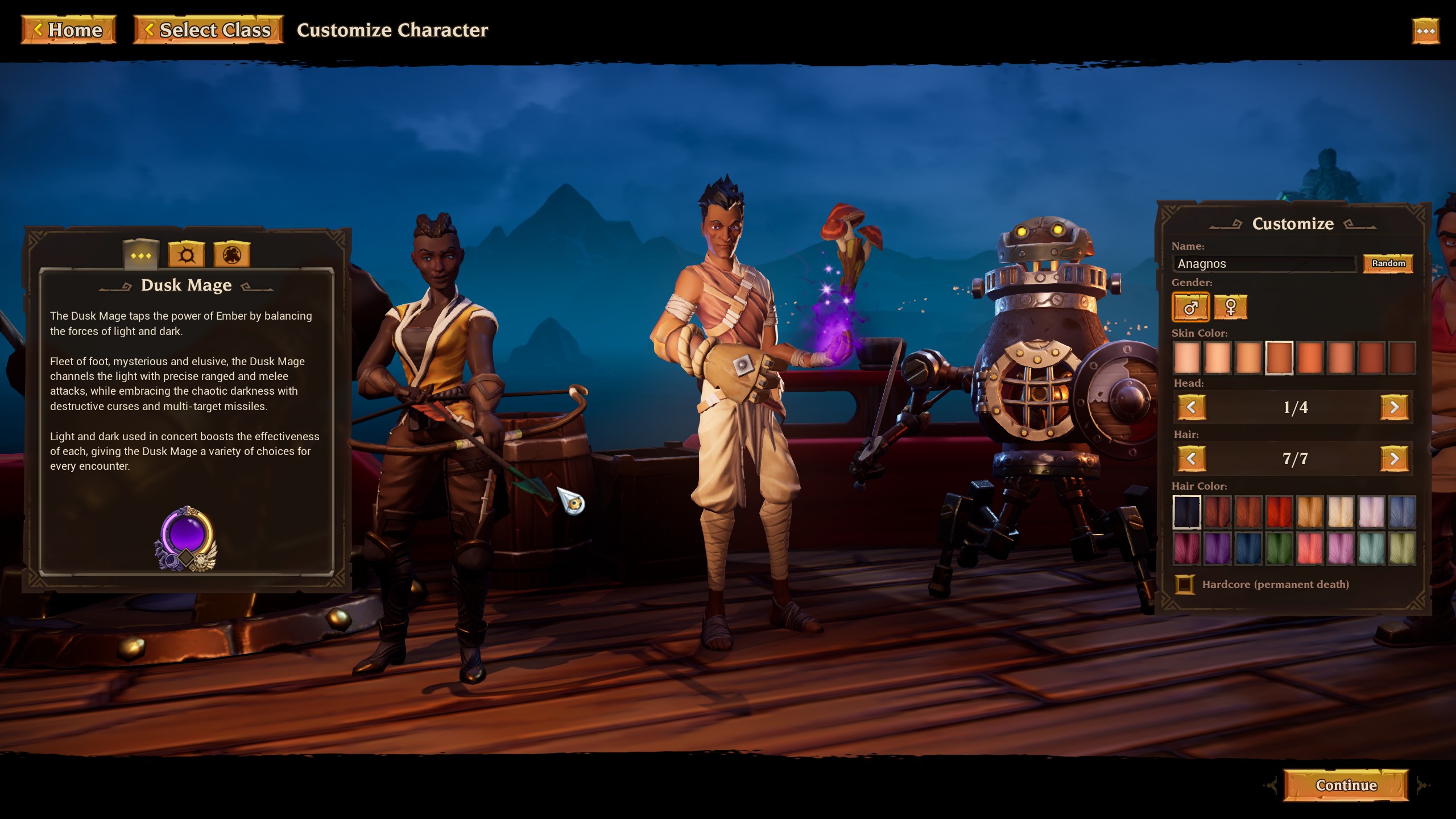
In addition to the selected relic, each class has two categories of Base Skills. Sharpshooter uses Precision and Adventurer skills to focus on ranged and dodge-based mechanics, but also features pet support. Dusk Mage focuses on Light and Dark magic (which there is no resistance for). Forged has Barrage and Brawl skills, which encapsulates both ranged and melee attacks. Railmaster has Conductor and Slammer, which are all about whacking with your giant hammer and empowering the train with mounted guns and a flamethrower. The combination of available base skills for each of the two class categories is 14, but with the relic selection, the combination grows dramatically. Playing a Blood Drinker Dusk Mage focusing on Light magic is completely different from playing a Bane Dusk Mage focusing on Dark Magic. This is how TL3 enables dynamic play with a pool of only 4 classes. Each class also has different “mana” or “charges”; for example the Sharpshooter has Ammo while the Railmaster has Endurance.
One thing I want to mention is the unique play styles available to the classes as it relates to other cookie cutter ARPGs. TL3 did a good job of creating a simplistic system of skills that is unlike any other ARPG. I’ve never seen a class like the Railmaster, and the Forged robot is hilarious and fun.
The Story of Torchlight 3 is pretty basic, told through animations and events, all taking place in the world of Novastraya. I will admit to never paying attention to the story, so I can’t really say much about it other than I know it’s very limited. I’m OK with that since I play these games to fight and farm, not to learn about the drama behind the fight. Speaking stones are spread throughout the world, which provide narrative support for each region and the upcoming boss fight.
The World Size of TL3 consists of 3 acts and 3 towns. There are mini-dungeon “rooms” spread throughout the world, but they are so infrequent and small, I’m not sure why they were included. Act 1 focuses on Goblins (Fire). Act 2 focuses on the Hive Insects (Poison), and Act 3 are Voltura/Machines (Electrical). While there are some random layout changes to the maps, they feel more static than dynamic in design. However, the placement of chests and spawns of monsters are what really feel different with each playthrough. While the overall world has great color, design and synergy with each act theme, there’s a limited feel to the content provided. It feels much more stale than what we saw with Torchlight 2 at release. The quality is there, it’s just limited.

My wife, who doesn’t play ARPGs, but has seen me play D3, Grim Dawn and PoE was immediately attracted to the artistic style of TL3, saying “that looks fun to play!’ She never said that about any of the other ARPGs I played, so that says something about the style of the game attracting different players.
One thing I don’t like is how there are no big open areas; all maps present as more of a maze than anything. There’s nothing like the deserts of TL2, which were some of the best areas.
Fazeer’s Dun’djinn is the end-game “challenge” map system that’s unlocked when a character completes the storyline. The system presents a collection of 3-5 “levels” that must be completed with a set of modifiers (such as extra monster hit points or attack speed), with the last level being that of a boss. The player can select one of three variations (through cards they flip over) of each level to play. The 1st challenge level of the dungeon has level 46 monsters, and the first challenge set has no monster modifiers, however the second set (levels 4-7) have +50% monster move and attack speed. Levels 16-19 have a 30% chance monster can blast a pattern of flames across ground. Challenge level 16 is monster level 60, and the max challenge level is 251, but the monsters are always level 60. The Gauntlet (respawning monsters but no loot) with Infamous (double fame) is the best for power leveling. If a character fails any of the challenge levels within a section before defeating the challenge boss (the final card of the section), the character is pushed back to the beginning challenge level of that section. I don’t care for this system because it forces the player to do the exact same thing again to get back to where they were (the cards don’t change); plus many of the modifiers for challenge levels (such as Angered Ancestors) are simply dumb and ruin the fun/challenge factor. Ultimately, Fazeer’s needs a lot of work to be something players can really focus on and enjoy. Once a character completes a Fazeer Challenge level above 60, that number will now appear above the character while in town. This is why players can see other characters who show a “level” above 60. The highest I’ve seen is 251, so there are players who have completed every challenge level of Fazeer’s. Also note Fazeer’s Dun’djinn level is character based, so a new character must start from scratch and go through the dungeon from the beginning.
The game also has Supply Run Maps, which provide a bonus to finding either items or gold. These are acquired as a contract reward every 10 levels, and currently provide the best rewards until Fazeer’s is enhanced.
There are also Phase Beasts that spawn mini-boss dungeons when you kill them. What’s interesting is I haven’t seen a single Phase Beast since I got to end-game, so it appears they aren’t spawning at all once you hit 60.
Continuing its standard of simplifying many systems that so many other ARPGs have over-complicated, TL3 does the same with Items. The game features Weapons, Armor, Pet, and Consumables. That’s it. Weapons come in 1H, 2H and offhand variations. Armor slots are Helm, Shoulder, Chest, Gloves, Pants and Boots. Pets have Collar and two tags. I cover the stats and underlying item properties below under Mechanics.
It’s important to mention that item drops relate to the class you’re currently playing. If you are running a Forged character, Legendary (and non-legendary) items for a Forge are much more likely to drop than those for another class; this is a good design, ensuring there’s a higher chance of receiving items for your class than other class-specific items you cannot use.
Players can attune non-legendary items to their character (which increases the stats by 20%) by using a Scroll of Lifebound. This is great for damage and defensive enhancements, but if your character dies, any bound items on your character or in your inventory are destroyed. The problem with this mechanic is most players forget to keep a “backup weapon” on their character, so if they die and lose their bound item, they find themselves completely unarmed and unable to re-arm without leaving and losing the dungeon instance. What the developers should have done was revert the item back to the non-enhanced state and then locked it from being attuned again.
Socketed items don’t start dropping until you complete the storyline, and players can use the Enchanting system to augment socketed items (which is covered below). Items have level requirements ranging from 1-60, but there are no stat requirements.
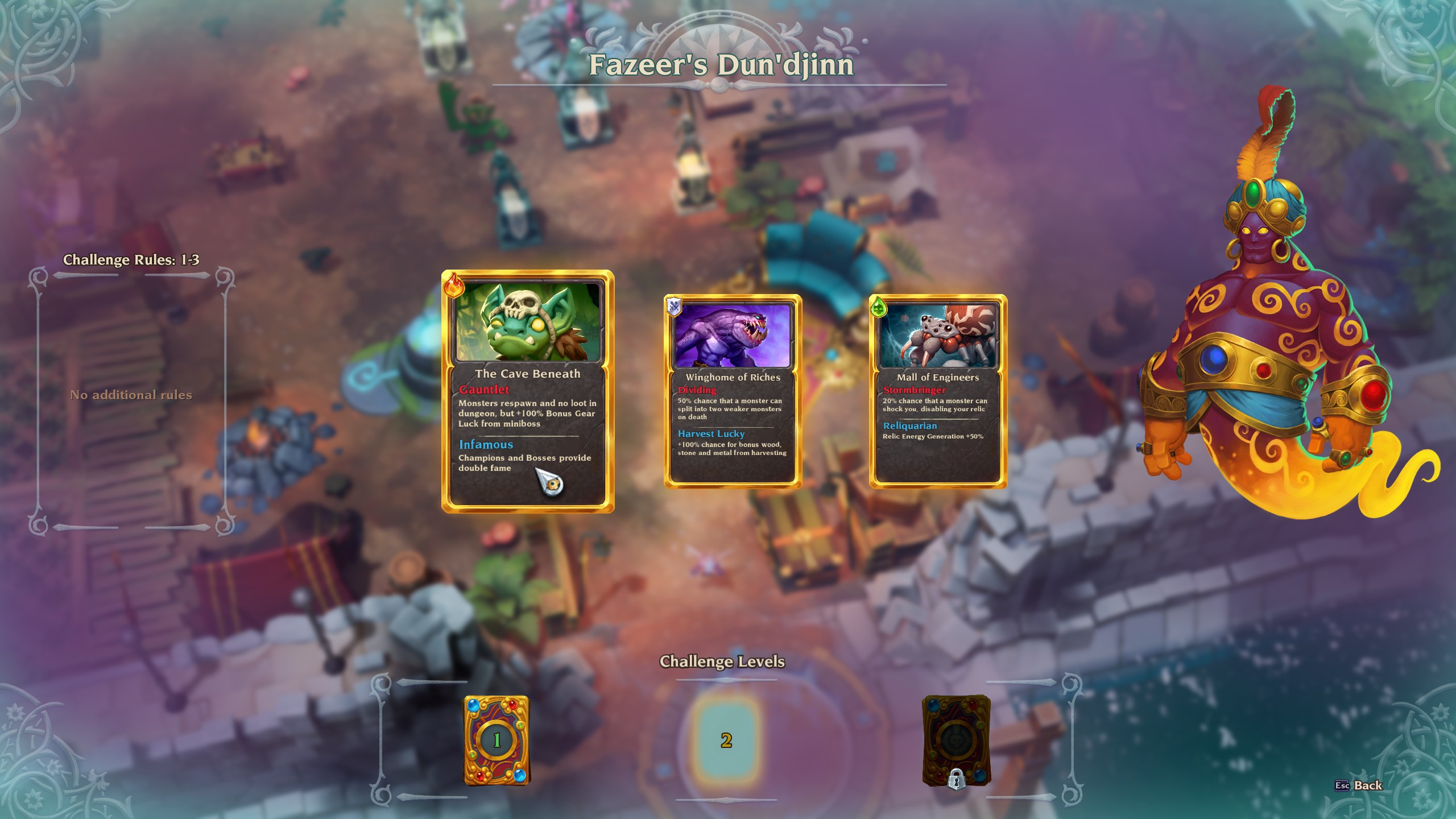
The Legendarium is similar to the Diablo 3 Kanai’s Cube. The difference is every legendary a player finds automatically unlocks the item for use by any character on that account. A character can socket one item at the start of the game, another at level 20 and a final legendary at level 40. The items that are selected make a big difference, so collecting legendary items to increase the available options in your Legendarium is part of the end-game farming available for players.
Quests move the player through the campaign story and provide the occasional reward, but that’s about it. The reality is the quest system of TL3 is pretty weak; but I’m OK with that since this is an ARPG and it’s all about character growth and loot. Characters generally complete the Story around Level 43-46. In Ridiculous, classes struggle between 10-25 or so.
Traps are found throughout the world, but they don’t really add much to the game and are more annoying than anything else.
Materials for Harvesting are spread throughout each map. Any character can farm any node, and no special equipment is required. Note I cover the crafting system below.
There are Treasure Chests spread throughout the world, with a good portion of them being mimics you must fight and kill in order to get the loot.

The world is packed full of nasty Monsters, with the most common types depending on the act or map/challenge the player is running. This includes Animals, Demons, Machines, Undead, Bugs, Giants, Humanoids, Magical creatures and more. Monsters come in the following flavors: Normal, Minion Pack, Elite, Legendary, Unique, Mini-Boss and full-on boss. Note any monster type above normal awards fame for each kill, which is used to acquire contract rewards (covered below).
Pay attention to the monster names; they can be hilarious!
Pets in TL3 are similar to how they were in TL2. They can attack, take aggro, and be “scared away” if their health drops to 0 (which causes them to run off for two minutes before returning). A pet can also be equipped with a collar and two tags. Note the equipped items apply to your currently active pet, so you can swap without having to worry about changing items. Pets also give access to 12 passive abilities, and up to 4 at a time can be active. Finding new pets unlocks these passive abilities. Pets come in Common, Uncommon, Magic, Rare and Legendary quality, but I’m unaware of any impact the quality has on the actual pet, but I’ve heard the acquisition of some skills requires the legendary version of the pet to be found (which is very rare). The most common means of acquiring a pet is in the boss room of an act boss or a map/challenge boss. I personally like the variety of design of pets; there are few games where you can have a killer llama or housecat at your side, killing and taunting monsters.
Player Forts serve as the home base of operations for all characters of an account. The Fort is built, shared and upgraded for all characters on an account. It also provides numerous enhancements to resistances, luck and other stats, as well as the stations necessary to swap pets and respec skill points. Forts also have wardrobe statutes that can be outfitted with gear selected by the player, but the reality is wardrobe statues aren’t really useful and I doubt many players will use them. The centerpiece of the fort is the Blooming Luck Tree. This is a tree that you feed extra items to grow, and with each level (5 is the max), you gain 1% global luck for your account. While you can’t put a merchant in your fort, you can quickly transfer items to your pet and have it auto-sell in 10 seconds.
One important feature that isn’t really presented to the player are Monuments. These are structures that are built in your fort and then fed components to increase resistances. The structures are: Peeking Worldgnasher, Forsaken Fortunauto and Hyvidsbane Weed. The Worldgnasher takes Goblin Fury (Fire resistance), the Fortunauto takes Automation Gizmos (Gold Luck), and the Hyvidsbane takes Hyvid Paste (Poison resistance). These components are automatically picked up as you adventure through the world, and the player is really never made aware of them (or how many they have) until a character goes to a Monument to turn them in.
There really isn’t a Tutorial for the game, which is surprising; but the simplified nature of TL3 makes it easy to dive in and start having fun right away.
Rumor has it TL3 is going to focus on Mods for future single-player experience, but at this time there are no mods for the game.
There aren’t any in-game Titles or Achievements, but there are Steam Achievements.
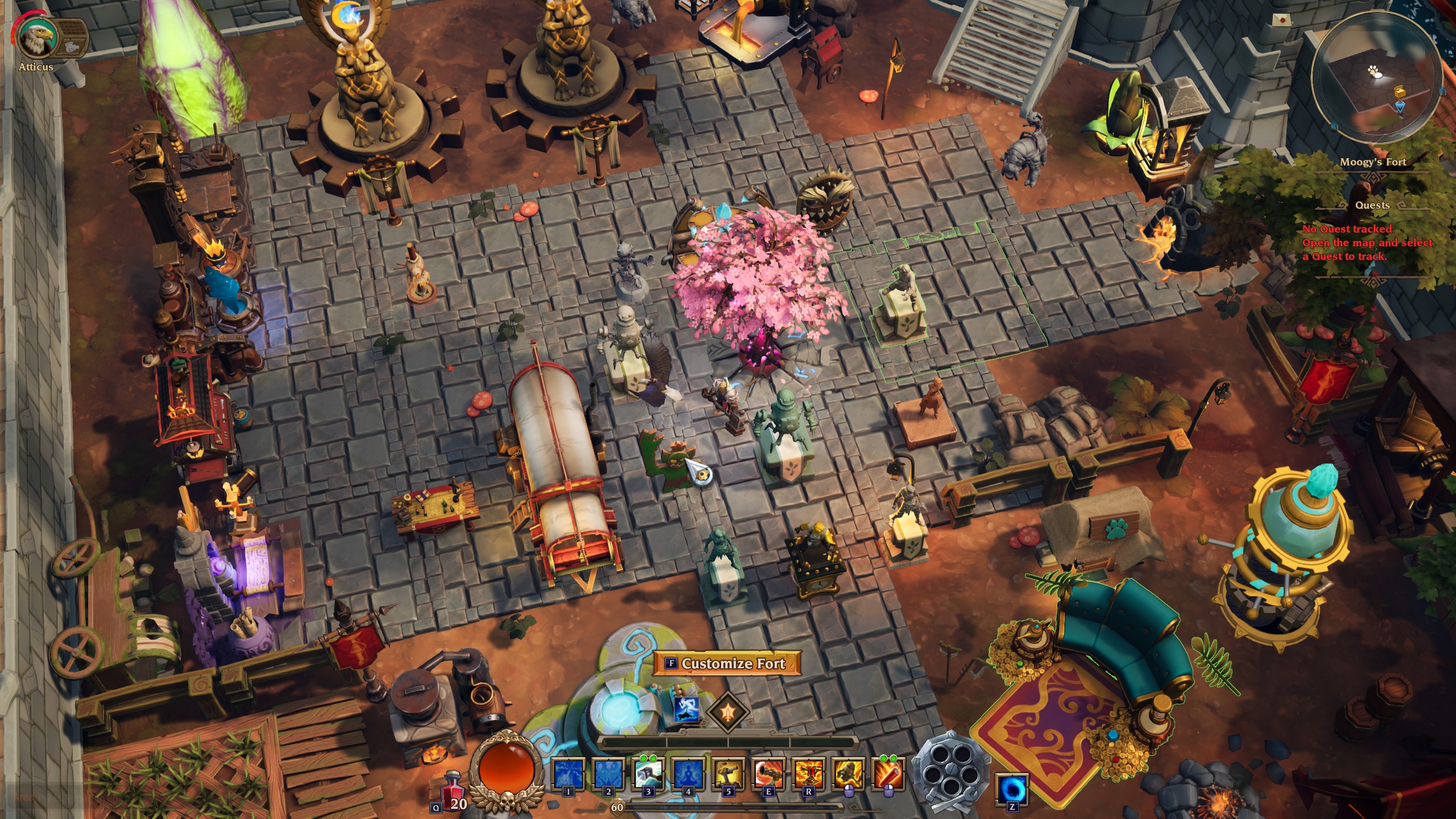
Gameplay & Mechanics
TL3 uses a transparent shared server system for everyone in Multiplayer. While the core technology works well, the problem is it pairs people from all over the world, so it’s easy to be thrown into a server with people who do not speak your language.
There are five Difficulty Settings for TL3: Practice, Normal, Hard, Painful, and Ridiculous. The higher the difficulty, the more health and damage a monster has and does, but a character receives more fame for killing elite monsters. A character’s badge reflects their difficulty, but it’s important to note once the difficulty is lowered, it cannot be restored. Note I’ve only played TL3 on Ridiculous, and recommend that difficulty level as I’ve heard the game is far too easy on normal difficulty.
TL3 has simplified the core Stat Mechanics so many other games have overly complicated, and it works very well. There are no stats (like strength, etc.). Instead we have Defense, Attack, Skills and Misc. Both Attack and Defense revolve around damage and resistance types (Physical, Fire, Poison and Electrical). Attack does feature Critical hit Chance, Bonus Critical Damage, Attack Speed, Knockback and other standard modifiers. Skills focus on Damage Bonus, and Misc is everything else (such as Luck, Regen, etc.). It’s also important to mention all classes are capable of doing DoT damage, which is based on a skill or weapon. This means a Sharpshooter can poison DoT their targets if they choose the Bane Relic with a Poison weapon, or a Forged Cycloner can equip a fire weapon that does DoT damage while also using the Electrode relic for electrical damage. This is a good dynamic design which allows for elemental and DoT focus based on equipment and shared relic skills rather than class selection.

Each class has a base resource called Relic Power that serves as the charge available for powerful attacks for each class. This power is charged as the character kills monsters, so there’s a balancing act of executing relic-eating skills vs. other skills while keeping the kill count coming in. The system is very smooth and functions well.
The Combat in TL3 is fluid and fun for the most part. Enemy attacks are properly telegraphed, and the only real issue I encountered were charging enemies from off-screen hitting me (without knowing they were charging), but the core of the combat system for TL3 is solid. But a key mistake made by the developers is the inability to set a skill as “always activate” regardless of range. For example, movement skills do not function the way players expect them to. Because there is no “cast regardless of distance” option, people think their movement skill doesn’t work when the reality is their mouse cursor is out of the radius of how far the movement skill can go, so the game tries to run the character there. This can be addressed by mapping the “hold position” to a key (like space bar) and when you hold down the key, any skill will auto-cast (including movement) even if the cursor is “out of range”. Regardless, this is a design problem the developers need to address. The other issue is the game refuses to target a new enemy when holding down the mouse button and you kill your target. This means you have to constantly be clicking nonstop, which is a terrible design.
Monster Mechanics are traditional for an ARPG; while TL3 doesn’t really bring anything new to the table here, it handles what we expect well-enough. Charging, exploding, spinning, AoE, and other attacks are standard from the enemies, and the group/unique/boss attacks feature similar affixes to Diablo 3 including Teleporting, Poison Blasts, Flame Tendrils, Electric fields, etc. Boss Fights are acceptable, but nothing exceptional. I do want to state TL3 has the best monster “spawning” I’ve seen in an ARPG. The way they crawl out of holes, up over the edges, or drop down from the ceiling is so well done, very few people realize it’s quite unique.
A character can hotbar 9 skills at a time. I haven’t had any issues with this limited number; it’s just fine for the available combination of relic and class skills. If a character has to use more than 9 skills at a time, the character is probably spread too thin for end-game viability.
TL3 is a level-based game, where the max Character level is 60. Unfortunately, at this time, there is no alternative advancement system in place (which I think is a mistake that needs to be addressed). It takes the average player around 20 hours to reach max level in Ridiculous.
Contracts are a passive account-wide reward system players can select to focus on specific types of rewards. There are three types of contracts: Adventurer, Craftsman and Homesteader. Adventurer’s focuses on gear and enchanting materials. Both Craftsman and Homesteader provide plans for Fort construction items, pets, and gear bundles with Craftsman focusing a bit more on pets and Homesteader on Fort items (statues, etc.). Contracts give a unique set of rewards up to level 40, then generate a “standard” of rewards that can be pursued indefinitely. This ensures core rewards are made available, and the player can then keep a standard set of rewards (based on the selected category) rolling in as they continue to play. Contract level is based on acquired Fame, which is awarded by killing Elite monsters (and the amount awarded per elite/boss kill is based on the difficulty setting). Contracts can also provide extra Character and Stash slots. Most players max out Adventurer’s first because it focuses on rewarding gear the character can use to level.
One thing I like is how the world is packed full of Breakable items; the most I’ve seen in an ARPG. It’s fun to destroy the scenery as you’re blasting through monsters!
Rewards are provided in numerous forms (including quest and contract rewards) with a focus on drops from monsters. The balance of rewards is good while leveling, but far too legendary items drop at end-game, which is a problem. One cool thing about TL3 is extra items that drop based on magic modifiers (luck) actually show in the interface, so when you see than extra blue or legendary item drop, a golden “luck” pops up, showing you it was a lucky drop that you normally wouldn’t have seen.
Respecticles are used to refund skill points so you can spend them elsewhere. The problem is the player only receives one respec point early in the game and doesn’t gain access to the station needed to execute a respec until the storyline is complete, so there’s really on way for a character to fix any mistakes they make while playing through for the first time or while leveling up, and the points don’t really start to stack up until end-game. This needs to be addressed because it locks people into a specific build (and potential mistakes) without a way to get out of it. Another key complaint is the inability to change a Character’s relic. I’m on the fence about this one because all relics are viable (except for Coldheart, which just sucks right now) with all classes.
Travel consists of running around, using Portals and Waypoints. There are no Mounts.

The only real consumable in the game are Potions. There are three types of potions: Health (restores 60% health instantly and knocks back nearby enemies), Polarized (recovers 25% of health and 7% per second while granting shock immunity for 5 seconds), and Antidote (Clears poisoned status and recovers 25% of health and an additional 10% per second for 5 seconds). The potion system is poorly designed as the player must drag the potions around depending on the type of map/damage they are running (for example, at end-game, the player can choose to run an electrical damage map – which means they should equip a Polarized potion). I hope the developers change this system in the near future so management of different potion types isn’t a requirement to play end-game efficiently.
Death doesn’t cause any XP loss, but it will cause all Lifebound items to disappear, and if you’re in a Fazeer’s map, you will lose the map progress and reset back to the beginning of the current segment. If you die in the campaign or a Supply Run Map, you have the option of paying gold to respawn at the beginning of the map, or back in town.
The Crafting system is used to create items in your fort (but not gear for your character) and requires the use of resources, which are harvested throughout the world (stone, wood, etc.), awarded through contract bags, and refined at crafting stations, such as a lumbermill. There are three categories of items that can be crafted and placed within a fort: Decoration, Functional and Storage. These cost resources to craft and place, but once crafted, you can pick them up and place them back again at any time. The crafting system definitely needs refinement to feel as if it really adds a lot to the game, but with some work, I think it can grow into something solid.
Enchanting is used to enhance items that have a socket. Enchanting recipes and the essence resource required to apply them drop throughout the world and can also be awarded through contracts. The player must construct and use an Enchanting Altar in order to apply recipes to their items, which are available based on the type of item (weapon, armor, etc.). The system is fairly basic; the player selects the recipe they want to apply to an item, and a random roll from that application is embedded in the item slot. If it’s not what the player wants, they must pay gold to disenchant and try again. This system is useful to get resistance or defense rolls on armor, or enhance the damage of a socketed weapon, but the overall system is very simplistic and doesn’t feel like it makes a huge difference at end-game (even though it technically can). Like crafting, Enchanting needs additional work to really feel useful.
There is no PvP in TL3.
Economy
Unfortunately, there is very little to the economy of TL3. Gold is the main currency, and an account can only hold a max of 20,000 gold at a time (shared between all characters). I find this cap unnecessary, and it should be removed. Gold is used to gamble buy items, enchant socketed gear, and build fort items. The good news is gold is automatically picked up, as are the Fort Monument currencies (covered above). All of the gathered resources (wood, ore, essence, etc.) can all be seen on the last inventory UI tab.
Each character has 20 inventory slots, 20 pet slots and 3 potion slots. The Shared Stash (account-based) has up to 9 tabs that can be unlocked with 20 slots within each tab, so a total of 180 slots for shared account storage. This is ample room for collecting equipment, and it doesn’t include the ability to store items on Wardrobe Statues in the Fort, so technically, a player has quite a but more storage space than even what’s available through the stash.
While a player can move items between their own characters using the stash, there is no trading allowed between players, however Max Schaefer said they are considering adding trading between players who party together.
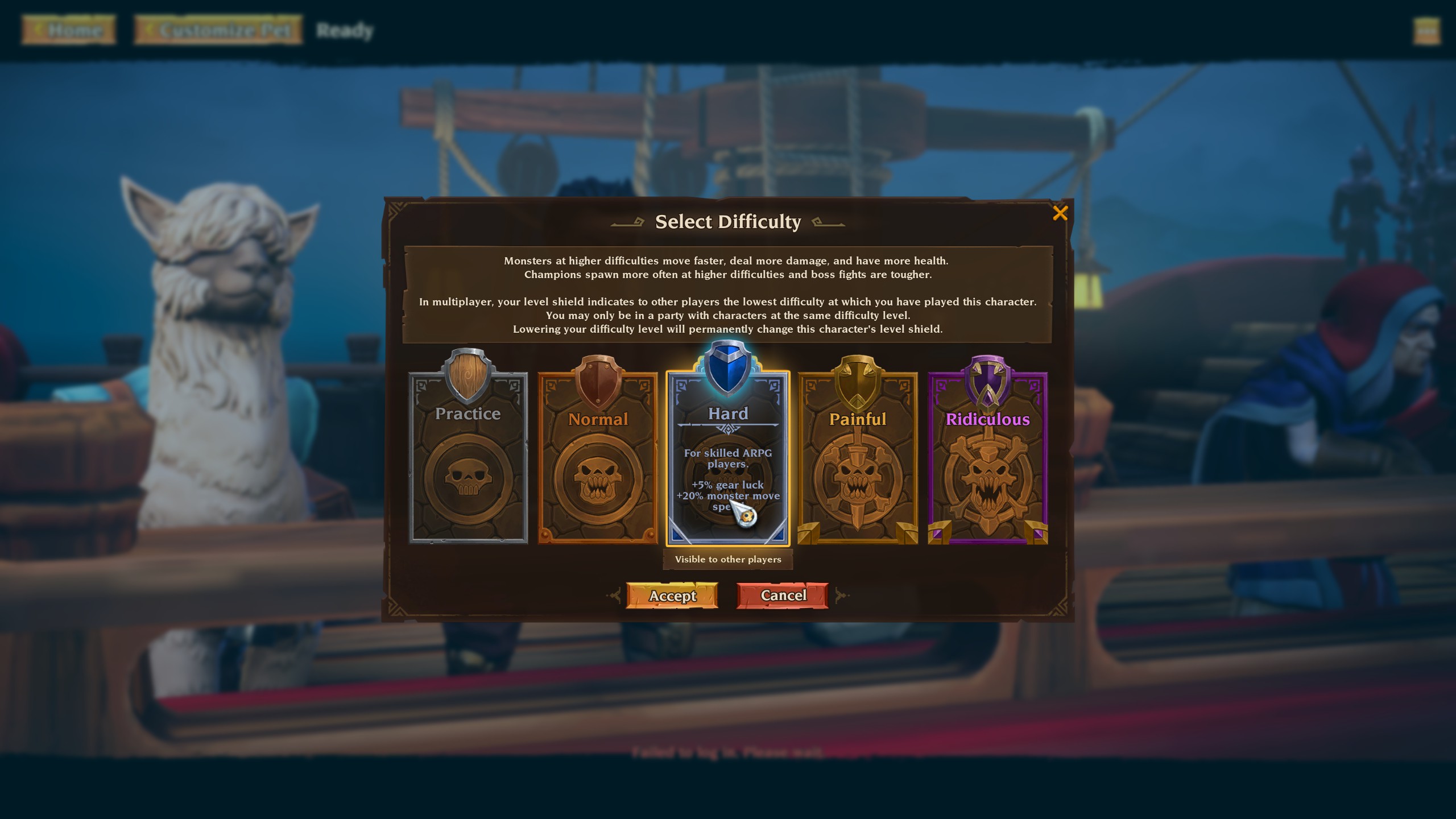
Community
TL3 features both single-player and multi-player modes. When in multiplayer, the character joins a shared instance for towns and forts, and can party up with other people. What’s cool is while a character is progressing through the storyline, they get to walk by (and into, if they desire) other people’s forts. There is also a global (server) based chat system where people can talk and group together. Unfortunately, items cannot be linked in chat (yet).
Partying with others is actually quite fun (max party size is 4), even though item drops aren’t shared or tradeable. XP is evenly split, so power leveling others is easy. All a high level character needs to do is run a Gauntlet and let the other party members sit in a corner and everyone gets the experience points. While four people can run together in a party, I think the most fun size is two people due to the mayhem of visual FX on the screen from combat.
As mentioned, one problem with the shared server system is it features players from all over the world, so it’s easy to run across another player who doesn’t speak your language.
There are no guilds, which I think was a big oversight by the Developers. They could have easily added a Guild Fort system and brought players together with these groups. I certainly hope they decide to enhance the community aspect of the game in the near future. The potential is definitely there!
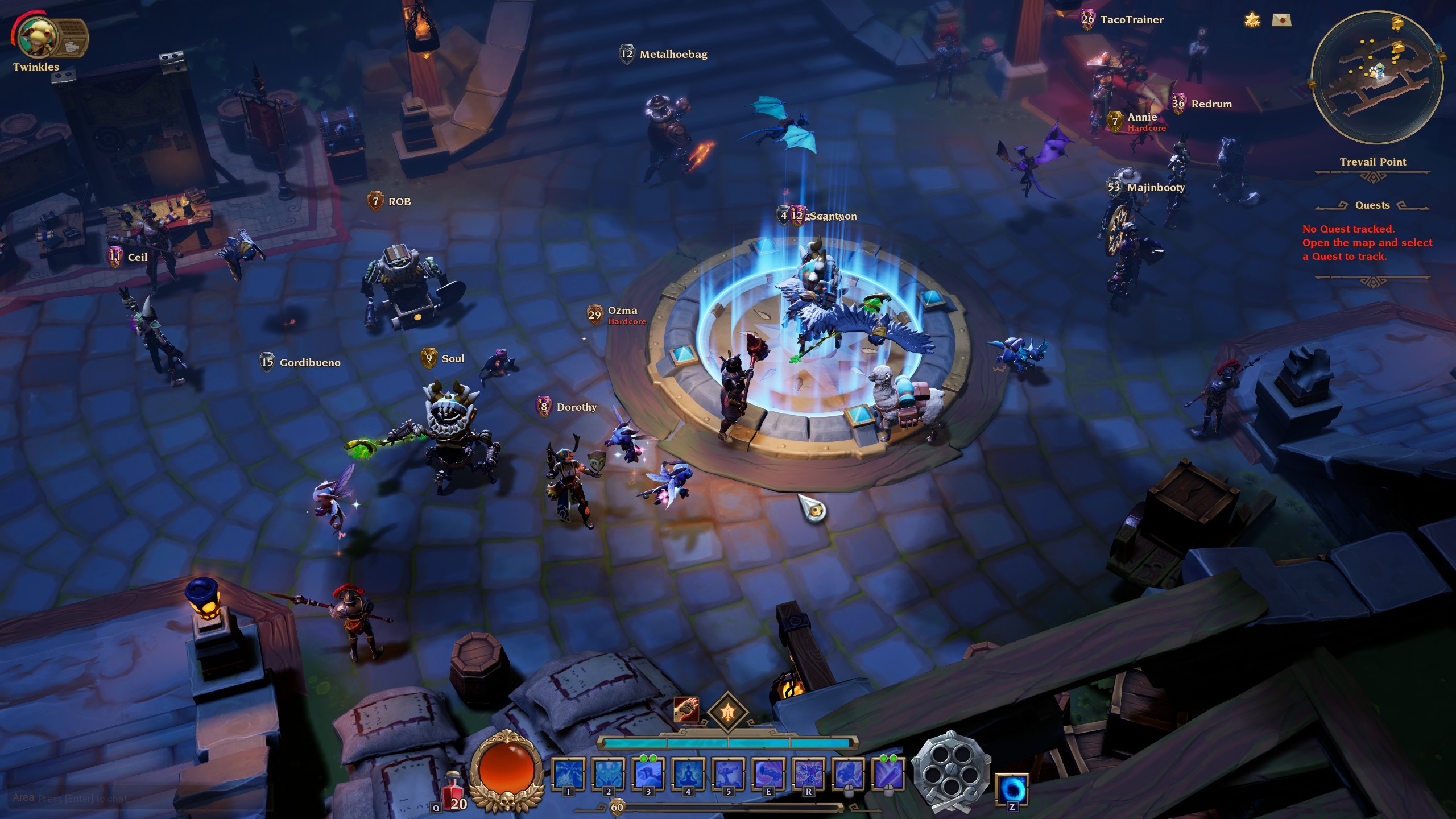
Technical
The Graphics of TL3 are quite good (the game uses the Unreal engine). The unique Torchlight Cartoon Franchise look and feel is well presented through detailed textures, multi-layered environments, clean particles, smooth animations and fluid combat. The character, pet and monster models look good, and the skill FX blend great with the cartoon-style world. The visual representation of a character’s gear is also solid.
The Sound is very well done; better than most ARPGs, and the Music is fantastic because it was created by Matt Uelmen, the genius behind the original Diablo I and II music. Ultimately, when it comes to Sound and Music, TL3 shines more than its predecessors.
The User Interface is fairly basic, and works fine. The most common issue players can’t figure out is how to drag the world map (while running Campaign) to move between acts. Simply hold down the right mouse button and drag. It’s also important to map a key (I prefer space) to the “hold” action so a character can execute any skill, regardless of where it’s cast.
The game is Multi-platform, and just launched on Switch. If they add some sort of party matching tool, I think Torchlight could be very successful because it is fun to play with other people.
When it comes to Connection, the Megaserver architecture is solid; I’ve rarely been disconnected, and have never encountered any latency that affected gameplay (US West Coast).
While the game has been out less than two weeks, there are a number of bugs or QOL (quality of life) issues with the game. Below is a list I created:
- Loading Times are the biggest problem with the game, but only in multiplayer mode, which says it’s a data synchronization issue that could be fixed.
- I haven encountered problems where running maps doesn’t drop all the items necessary to unlock the boss, so I had to abandon the map. This happens at least 10% of the time, which is a lot.
- Some maps have missing bosses, so you can’t complete them.
- There is no special Sound FX or mark on the map when a Unique drops.
- Sometimes the game will forget where you are if you go to town then fort then back to your portal (it will put you at a different location, causing you to lose your last portal cast point).
- If you port out before entering a phase beast portal, the phase beast portal disappears.
- The continued dropping of known recipes and not changing the colorization is an issue.
- Quite often the game will “hang” or “kick out” of entering a portal to either go to a map or to leave a map.
- Item drops are terrible at end-game; some players won’t see more than a single legendary in 1-2 hours of gameplay (end-game grinding); and when they do, it’s one of the same they’ve found time and time again.
If the above issues are addressed, I believe the game will be much more enjoyable. The developers should be able to fix all of these problems (and more) in just a few weeks.

End Game
One of the most important things a ARPG must do right is not only attract, but retain its players with enjoyable and challenging end-game content that allows for hundreds, if not thousands of hours of gameplay. Unfortunately, Torchlight 3 falls short in this department. Very short. There simply isn’t enough to do at end-game, and that’s probably the #1 reason people are quitting.
Right now, the only available options for end-game are:
- Hunting Legendaries for the Legendarium (with terrible drop rates).
- Gear hunting for your character.
- Pushing Fazeer’s dungeon level (which only gives you a banner above your character name, and provides no other reward).
- Maxing out Fortress resistances and bonuses (which can be done in under a week).
- Getting all of the base Contract rewards (1-40) for each category (which can be done in just a few days).
As you can see, the above list is a big problem. There’s very little incentive to play end-game at this point, and recreating new characters with the limited content is just boring. These problems need to be addressed by the developers ASAP if TL3 is to have a future. But I want to say again: the potential is there.

Conclusion
The core of TL3 is solid, and it is a fun game with unique classes, a semi-comical play style, and excellent visuals, sound and music. While it’s lacking in extensive replayable content and end-game depth while having a number of bugs, the potential of expanding into a competitive ARPG is definitely there. We’ll have a better idea of what the future for TL3 holds based on the changes pushed by the developers over the next few weeks. If we see regular fixes and content pushes, TL3 could be a solid ARPG contender in the months to come. Until then, it definitely needs more polish, content, and end-game variety.
